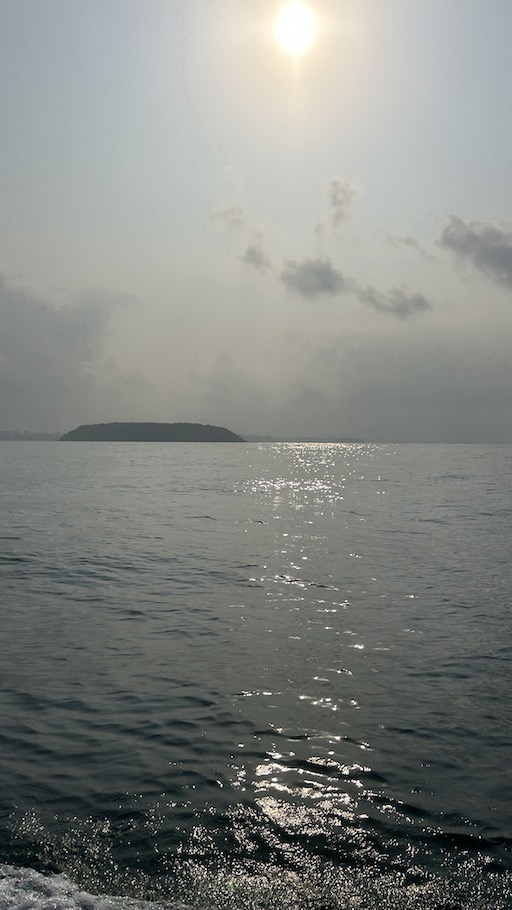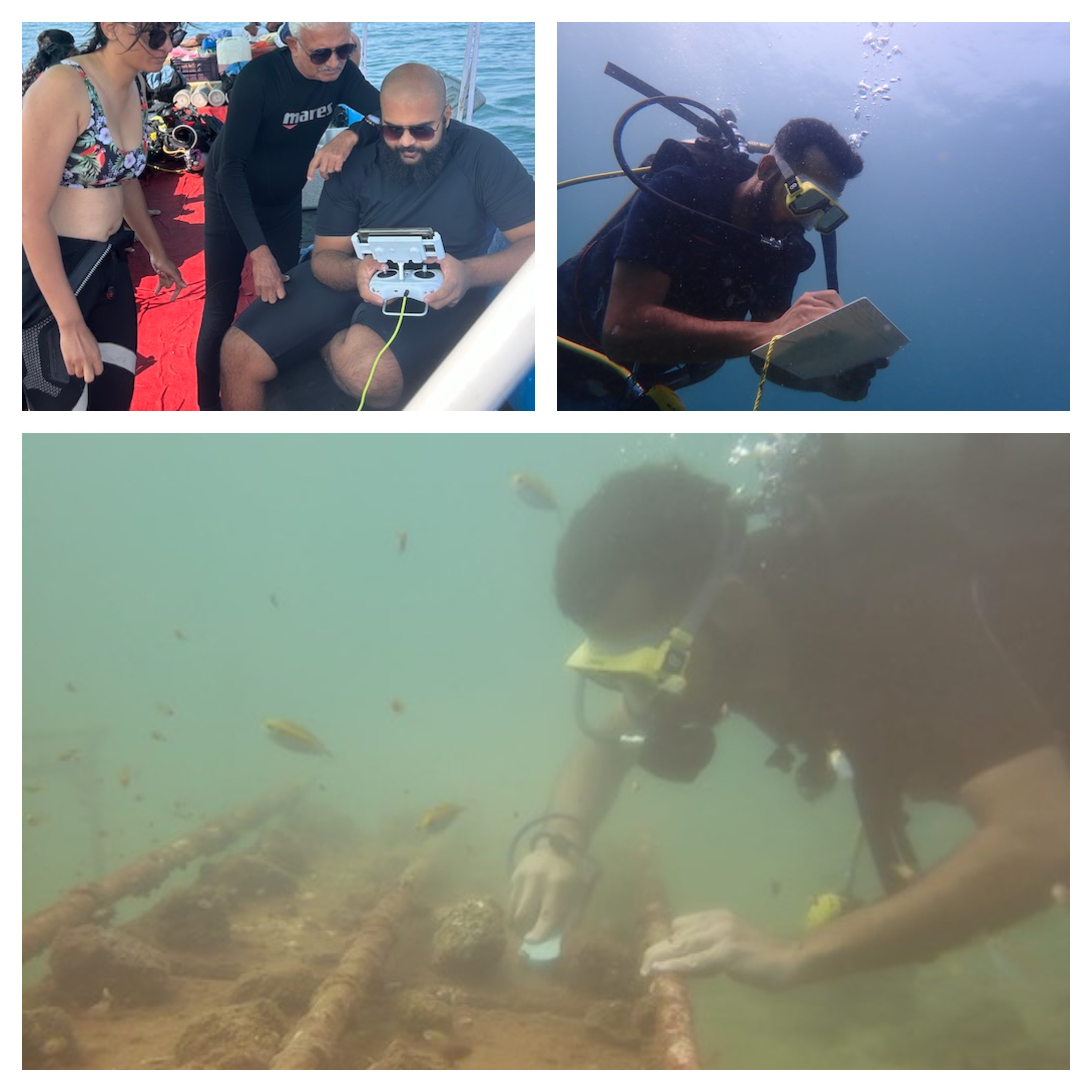I have shifted to Goa and by now, have spent some time working with two very interesting NGOs, Technology for Wildlife (TfW) and Coastal Impact (CI). With both of these, I have gotten opportunities to engage in fieldwork. With TfW, the fieldwork is more terrestrial and drone-based while CI offers boat trips and scuba diving. This is probably the first time I have actually got paid to get away from my laptop and do some interesting on-the-ground work (akin to how I once went on a bike ride at Locus as a pillion on one of our delivery partner). It’s new and it’s fun!
Doing fieldwork is equal parts fun and tough. While it is extremely rewarding and usually comes in with a lot of planning beforehand, it also comes with a guarantee that things won’t go according to plan. So please plan all you want, nature doesn’t care. There is some amount of variance that the environment creates. Having a lack of proper tools, or rather the choice of tools, also creates some variance in how effectively we can execute our goal. Nevertheless, there is a certain joy found even in watching things go completely off and wrong. To be told by nature, that no matter how well you plan, you will still err in front of her. Keeps you humbled and forever motivated.
The more data we collect and the more tech-savvy our world becomes, the more points of uncertainty we are able to capture. The more in control gets nature. The better we are able to plan. Our effectivity in carrying out tasks increases with time. Although this is natural and the desired outcome (of growth, life, and beyond), it still feels weird to think that maybe one day in the future, we will be at a point where our need to establish certainty has created a perfectly predictable environment. Much like a plantation from a forest. A sad yet inevitable truth. Nature is so much more beautiful when it’s unpredictable, angry, and a little eccentric. When you don’t know what abuses it might lash out with at any given moment, when it’s prone to road rage, when it’s slightly heavy-handed. Keeps us in awe.

CI Fieldwork
When we go out for dives with CI, we try to prepare everything in advance. We have a dive plan that gets decided a day or two back. This dive plan, now thanks to me, gets formally written in a web app. Further, all equipment that has to be taken for the dives gets listed in a checklist on the same app. Volunteers get contacted a couple of days beforehand. With all this taken care of, we are usually as ready as we can be for the day!
Our dives can vary in terms of the work we do. We can be tasked with cleaning of our artificial coral reefs, surveys of particular sites where we are studying the marine life and benthic conditions, monitoring of coral growth across our sites by clicking pictures of our subjects, mapping a dive site, setting up an artificial coral reef, coral sourcing and transplantation and sooo much more!

For all of these ‘dive days’ we end up waking super early and convening at the Coastal Impact HQ in Aldona around 6:45am. We fit everything from kits to tanks to equipment into our ’now partly a zombie’ van and meet other divers at the Dona Paula Jetty around 8am. We proceed to load everything we are carrying onto the boat by forming a chaotic yet effective human chain to ease the load of passing tanks, tools, the chai container (hehe), etc. on our constantly abused back. Once loaded, we depart for Grande Island. The boat ride ranges from 45 minutes to an hour. We spend that time to prep our kits, dive equipment, slates if we are on surveys, etc. This time is also used up in talking to volunteers and figuring out the teams in which we will be operating along with explaining them their roles. It’s all prep time. Not really a lot of free time.
Once we reach the island, our search for our dive site begins. Almost all our dive sites are marked with mooring buoys that we can moor with. So knowing the approximate location of the buoy or having a GPS point marked on our phone or on a Garmin handheld GPS device is super important. We usually use a combination of these techniques to find buoys. Sometimes though, our buoys seem to disappear. Even after reaching their appx. location, we sometimes just aren’t able to find them. This is followed by lot of jumping about on the boat, loads of moving of the boat from one place to another, some amount of swearing, and a realisation. That either the wave action and the currents have submerged them for now (in the case where the sea level rises above the buoy) or they have been pulled apart from the rope (either by fellow humans or by the force of nature itself).
When we do find the buoy, we moor, and start dropping in one by one into the ocean. Teams go one after the other and all team members meet up at the descent line (anchor line of the mooring buoy). From here, we descend together into mostly super murky waters where greens dominate the more photogenic blues. Post reaching the seabed, our work begins.
I am not going to go on to describe the different types of work for now. We shall save that for another writeup.
We spend usually around an hour and a half working on each dive. This work, although, contains various aspects, also consists of us getting lost and surfacing multiple times to either find our bearings or find our lost friends. Since the water isn’t too deep, ~8m on average where we dive, bouncing to the surface and descending multiple times isn’t too tough and/or risky. Very doable. Once we are done with our first dive, we surface, swim to our boat, change tanks, take a surface interval of usually 45min to an hour, and start prepping for the next dive. Post this dive, we dekit, pack everything up, start heading back to the jetty again, load all the equipments and tanks into our van, and drive back to Aldona where a fun activity awaits us…washing everything (not fun at all. At all). But before that we usually end up making a quick stop to get some supplies like coke, energy drinks, chocolates, etc. Though we should start getting beers on the way because…what is even up with Goa’s humidity and heat levels!!! We wash our equipment, mats, kits, tanks, etc. which takes us about an 30-40 minutes. Mind you this is peak afternoon. The sun is strong. The force isn’t with us. We are usually dead tired after this, close to 3:30-4PMish. We help fill up some tanks, discuss any pending work, and head off for home where at least for me, a starving Ishan awaits me. Ready to Swiggy the fuck out of his Paytm balance.